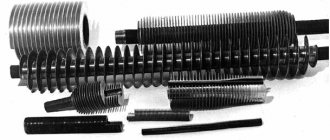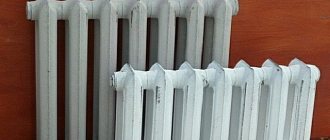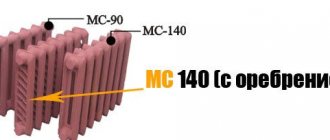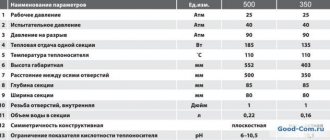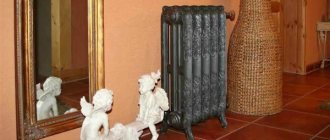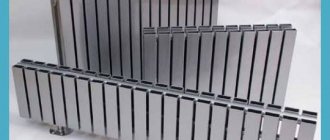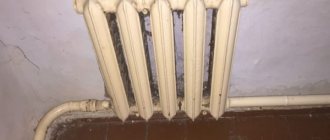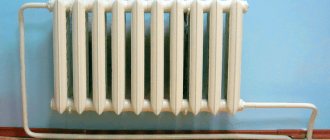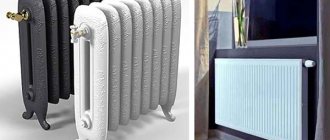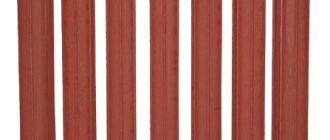Modern batteries attract the attention of homeowners with their ability to provide increased heat transfer. At the same time, it is hardly possible to call them an adornment of stylish interior design. It is often necessary to hide radiators behind decorative grilles and screens, thereby reducing the efficiency of the heating system.
Today, manufacturers offer a wide variety of design forms for modern cast iron radiators in retro style. A review of the models will help you make your choice.
Features of retro cast iron batteries
Cast iron batteries can look like steel and aluminum products in a modern industrial style. But the main advantage of the devices lies in the stylistic variety of section shapes and relief patterns on the cast surface.
Advantages
There are countless types of cast iron heat exchangers. You can choose a suitable device for almost any interior. Moreover, a trivial heating radiator becomes a separate original stylistic accessory.
Cast iron batteries have a number of other advantages:
- They do not require maintenance throughout their entire service life.
- Massiveness and large internal volume increase the thermal inertia of the heating system. This is an ideal option for use in combination with heated floors.
- Cast iron is resistant to corrosion, so thick walls will not rust even after fifty years of use.
- The variety of section sizes and connecting center distances makes it easy to select batteries for almost any interior.
- Large internal cavities are not clogged with mud deposits.
- The reliability of the design allows the operation of a steam heating system at a coolant temperature of up to 150 degrees Celsius.
- Manufacturers provide a guarantee of 10–15 years, but the actual service life most often exceeds half a century.
- Cast iron appliances are equally effective in heating systems with forced and natural circulation of coolant.
- Products are painted in a factory. High-quality enamel is resistant to mechanical damage, does not fade, or crack from repeated temperature changes.
In summer, the heating system must be filled with coolant to prevent air access and corrosion of metal surfaces. In practice, due to poor-quality shut-off valves and repair work, water leaks out and the metal rusts faster. Only cast iron sections successfully cope with this problem.
Flaws
Cast iron heaters must be installed taking into account their disadvantages. First of all, you should pay attention to the strength of the walls. If it is not possible to securely fix the brackets for suspended structures, then you need to choose floor-mounted radiators.
Other disadvantages:
- automatic temperature control systems must be adapted to the inertia of cast iron batteries;
- when used together with heated floors, it is necessary to connect the heaters to a higher temperature heat source;
- the operating pressure in the heating network should be within 4–6 bar;
- the large internal volume increases the time it takes to fill the system with water;
- inclined and horizontal stiffening ribs contribute to the accumulation of dust;
- heavy weight makes transportation and installation difficult;
- Retro-style products are more expensive than aluminum and steel ones.
When designing heating using retro radiators on legs, you should provide special channels under the floor for laying pipes. They must be as reliable as possible, since visual inspection of leaks will be impossible.
Comparison with other types of batteries
Taking into account the lower cost of more technologically advanced modern heating devices made of steel and aluminum, one must take into account their lower durability. They rust faster from the inside, so they will have to be replaced more often during major repairs. Cast iron retro heating radiators are an excellent option for rooms decorated in an antique style using fine wood, marble, and expensive accessories.
Does it make sense to change a design that has been proven over many decades of good service? The operating principle and internal structure of cast iron batteries remain almost the same as a hundred years ago. But when the need arises to replace reliable heating devices with more modern ones, you need to pay attention to alternative options.
Heaters are made from the following materials:
- aluminum;
- steel;
- bimetal;
- cast iron.
Aluminum creates galvanic couples with other conjugated metals. This greatly accelerates corrosion and reduces trouble-free service life. In bimetallic radiators this disadvantage is especially pronounced.
With periodic heating using units for burning solid organic fuel, massive radiators retain heat longer. On the other hand, using aluminum or steel batteries can warm up the room faster.
Modern heating devices have other advantages compared to cast iron:
- improved thermal conductivity;
- slight inertia;
- lighter weight for easier installation;
- minimum internal volume for coolant;
- low cost.
The design features of the batteries made of steel and aluminum allow the installation of individual thermostats that automatically select the most economical room heating mode. In this case, it is necessary to monitor the quality of the coolant: install filters, soften the water, using chemical reagents.
In summer, the system must be completely filled with water. If the liquid leaks, then in conditions of humidity and access to oxygen, corrosion processes will significantly accelerate, the metal will rust, and major repairs will have to be done ahead of time with the replacement of individual sections or radiators.
Design options for retro radiators
Manufacturers offer several design options for retro radiators:
- Buying a battery base with a layer of primer. The customer can paint the radiator in any color he wishes, having the radiator painted by a professional.
- Antique-style painting with the corresponding ornament applied to the radiator body.
- Painting in several colors.
- Coated with matte paint or treated with glossy paints.
The option of casting cast iron batteries according to an individual project is provided.
Cast iron retro radiators remain not only a magical element of room decor, but also an effective means of heating a home. Cast iron batteries are in demand in the radiator market due to their high technological performance.
Recommendations for selection
The price of cast iron retro batteries depends on the design - the complexity of the cast surface, the bas-relief pattern, and the quality of painting.
The technical characteristics of radiators are important:
- height;
- width;
- depth of sections;
- thermal power value.
Maximum durability of a painted surface can only be achieved if certain conditions are met. After applying special dyes, the products are placed in thermal chambers for drying at high temperatures and controlled humidity. It is impossible to replicate this technology at home, so it is more profitable to purchase ready-to-install cast iron batteries.
For the initial calculation of the number of devices, the specific power coefficient of the heating system is used, which is taken equal to 100 W/m2. If the room area is 90 m2, then 9000 W of heat will be required. If the average thermal power of one section is 150 W, then you will need to buy 60 sections. They are connected and placed most often under window sills. If there are six windows with the same dimensions, then you get 6 heating devices from 10 sections.
When calculating the required number of heating radiators, specific climatic conditions must be taken into account. It is obvious that in the Arctic Circle the winter frosts are stronger than in the central part of Russia. Calculations are made for each room separately. Then a safety factor is added to the power of the heating devices, which is 10–15%.
Criterias of choice:
- The design of the battery must match the interior of the room.
- Cost is often a deciding factor.
- Heat dissipation directly affects the number of batteries. The greater the efficiency of the radiator, the fewer sections will be required.
- Reliability must be guaranteed by the manufacturer.
- Durability of cast iron radiators (tested by time).
- The size depends on the number of sections, as well as on the height of the window sill, where the batteries are most often installed.
- Weight is only important during transportation and preparation for installation. If the walls are made of lightweight concrete, then you need to choose a floor option with legs.
For heating a cottage, the operating pressure in the system is insignificant, but in multi-story buildings it reaches high values. It is worth taking this factor into account and looking at the permissible pressure specified by the manufacturer in the product data sheet.
What are the differences
The scope of application of cast iron radiators in general is both apartments and houses. But with the “retro” style everything is not quite the same. Few of our apartments are decorated in a palace style. This is more suitable for spacious private properties. In addition, their parameters are also more suitable for individual networks (with rare exceptions). By parameters we mainly mean pressure - working and pressure testing. Here all radiators can be divided into two groups:
- Russian production;
- European production.
Some models from the Russian company RetroStyle
Knowing the tendency of our people to take everything for reliability with a large margin “just in case,” domestic manufacturers make radiators with decent operating pressure: 10 Bar, test pressure 15-16 Bar. Radiators from the Czech company Viadrus have the same parameters, but they have been on our market for a long time and have also studied the needs of our customers very well. All other companies produce products that will work at 6 Bar. In principle, for individual heating you don’t need more: the maximum that can be in such a system is 3 Bar, but basically everyone works at 1-1.5 Bar.
Review of retro radiator manufacturers
High-quality cast iron casting, the original shape of the sections, and the stylishness of the patterned ornament create the unique attractiveness of the new type of cast iron batteries. Their price is higher than standard models. At the same time, the antique design of heating devices organically complements the classic, Gothic or English style of room decor.
You can buy retro cast iron radiators in a budget version or order an exclusive design with a bas-relief ornament, patination or artificial aging of the surface. The cost of products is greatly influenced by the scale of production. Some models are made only to order, which significantly increases their price. Especially when compared with the cost of standard Soviet-style products. For example, one Russian-made MS-140 section can be purchased for 380 rubles.
Retro Style
A Russian brand that produces several collections of cast iron radiators in various styles: Empire, Rococo, Classicism, Baroque. The company provides an ordering service for painting batteries in accordance with customer preferences. You can choose imitation antique silver, Gzhel, red gold, bronze and other options.
The cost of one section of a vintage two-channel Retro Style Anerli is 16,367 rubles.
A battery of 5 low-profile multi-channel Retro Style Bolton sections can be purchased for RUB 19,219.
The Retro Style Chester cast iron radiator costs 41,696 rubles for 5 sections.
Prices for cast iron radiators Retro Style
cast iron radiators Retro Style
Guratec
The high-quality heating devices made in Germany are designed in a retro style. The surface of the sections is protected with powder paint that is resistant to mechanical damage. Before being sent to consumers, products are tested on hydraulic stands.
The Guratec Fortuna series radiator, priced from 140 euros per section, is decorated with a beautiful vine ornament, images of dragons, lions and angels. The patterned surface of the batteries, painted to match the decor, will decorate a classic interior.
Prices for cast iron radiators Guratec
cast iron radiators Guratec
Roca
The representative of the Spanish industry has a hundred-year history of development. The first products were produced by the plant in 1917. Manufactures a diverse range of heating devices from aluminum, steel and cast iron with a retro design. The Epoca model is popular - a battery of 6 cast iron sections, which sells for 29,420 rubles.
Demir Dokum
The factories of the Turkish manufacturer are equipped with automated production lines in accordance with modern European standards. Now you can buy in Moscow any of six models, which are presented in different standard sizes.
The products are distinguished by excellent performance characteristics, have a magnificent appearance, so they can decorate any interior. One section of the Demir Dokum Historic model costs 3,981 rubles.
Prices for cast iron radiators Demir Dokum
cast iron radiators Demir Dokum
Conner Modern
The products of the Russian manufacturer in the Art Nouveau style have good heat transfer rates. Products are manufactured using modern technologies. At a very reasonable price, domestic cast iron radiators are not inferior to European ones in terms of workmanship. The cost of a six-section Modern-500 series radiator is 4,080 rubles.
The final price of a cast iron retro battery depends not only on the number of sections, the popularity of the chosen model, and the product manufacturer. A kit completely ready for installation will cost more, but will serve more reliably and longer.
Types of cast iron retro radiators
According to their appearance, retro cast iron batteries are divided into:
- Batteries with ornaments and special colors. Elegant Baroque design or Gothic decorations on a dark background of radiators will effectively decorate the room, allowing heating devices to become part of the overall space. Retro radiators are decorated with either paint or cast floral patterns.
- Classic Russian cast iron batteries can also become an element of post-Soviet style. As a material, cast iron has long proven itself on the positive side.
According to the installation method, retro radiators are divided into:
- Hanging (attached to hooks in the wall). This installation method allows you to organize a hidden battery connection.
- On legs. The large weight of cast iron batteries will force manufacturers to think about an alternative installation option, which is why retro radiators are often mounted on legs. The battery is simply placed on the pipes and connected to the heating circuit. However, the floor must be perfectly flat and adapted to bear such a load.
By type of sections:
- Sectional radiators allow sections to be expanded after installation, which is very convenient considering the weight of the structure.
- Monolithic radiators are more reliable, but in this case it will not be possible to expand sections. However, water leakage between the seams can also be avoided during operation.
Rules for installing retro batteries
You can begin installing radiators only after checking the connections between sections. Tightness is ensured by gaskets made of heat-resistant rubber or paronite. The batteries are placed at a distance of 30–50 mm from the wall to ensure convective heat exchange. Systems with natural circulation are installed with pipes sloping in the direction of coolant movement.
To carry out proper installation, you must be guided by the “Building Norms and Rules” (SNiP):
- Determine the exact location for installing the radiators.
- Install brackets for pendant batteries.
- Equip radiators with plugs, air release valves, shut-off valves, and adapters.
- Install the heating devices in their places.
- Install the piping.
- Connect the radiators to the inlet and outlet pipes of the heating system.
- Remove the protective film from the surface of the sections.
The connection of heating devices to the heating system depends on the chosen flow pattern of the coolant, as well as on the location of the main pipeline in multi-storey buildings: with lower wiring in the basement or with upper wiring - on the technical upper floor.
There are three main ways to connect radiators:
- Bottom connection. Most often used in cottages. This method allows you to hide pipes under the floor and favorably emphasizes the aesthetics of designer radiator models.
- Lateral connection. Used for heating systems in multi-storey buildings. The supply pipe is connected to the upper futark, and the return pipe is connected to the lower one. This is the most efficient connection scheme in terms of heat transfer from radiators.
- Diagonal method. It is used for two-pipe horizontal distribution for one-story buildings. The supply pipe is connected to the top of the heating device on one side, and the return pipe is connected to the bottom on the other side.
To connect radiators to the pipes of the heating system, valves and taps are used, stylized as antique designs. Products of this type are manufactured by Italian companies Carlo Poletti and Rubinetterie.
Restoration of old radiators
High-quality cast iron products sometimes last more than 100 years. During the major reconstruction of ancient buildings, valuable rare pieces of heating equipment made in the 20th or even 19th century are discovered.
To give a second life to an old cast iron battery, you need to perform a few simple operations:
- Remove the radiator and move it outside the building.
- Disassemble the device into separate sections. A special liquid will help soften rusted threads.
- Remove old paint from the surface. While heating the section evenly with the flame of a blowtorch, remove many years of deposits with a spatula and a flat-head screwdriver. Residues are cleaned off with emery cloth.
- Rinse the internal cavities of the sections with tap water under maximum pressure.
- Drain the water and dry the radiator.
- Assemble the battery using new nipples and paronite gaskets, install plugs.
- Degrease all surfaces with solvent.
- Then prime and paint the radiator.
- After complete drying, install and connect the battery.
The updated cast iron radiator will be able to serve its intended purpose for many years to come. At the same time, it will still delight its owners with its unique design. Read about bricks for stoves on our website.
